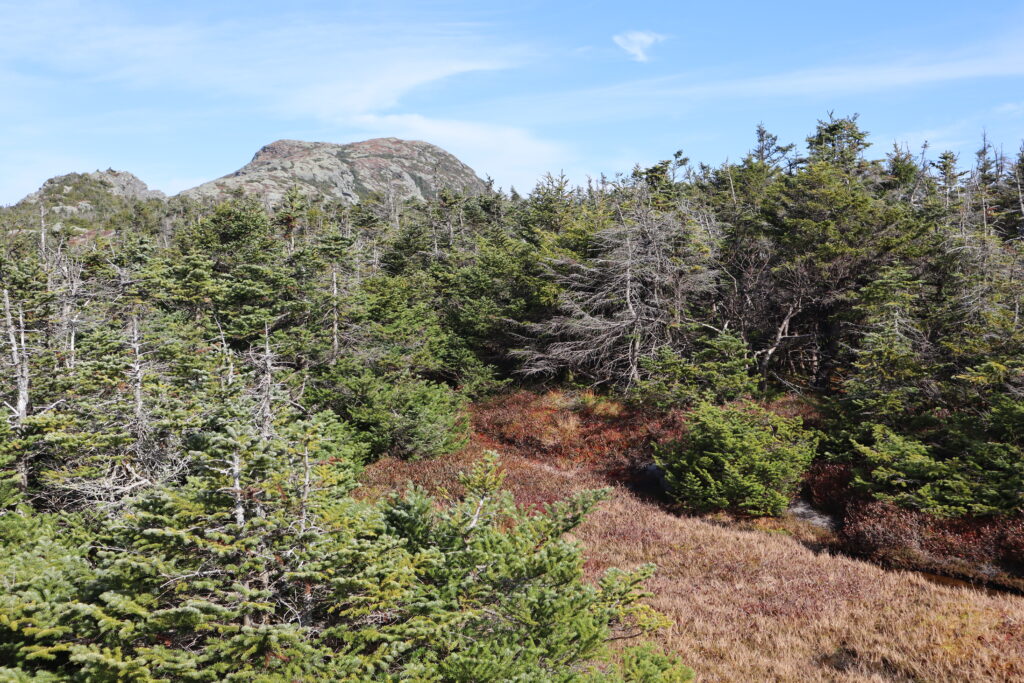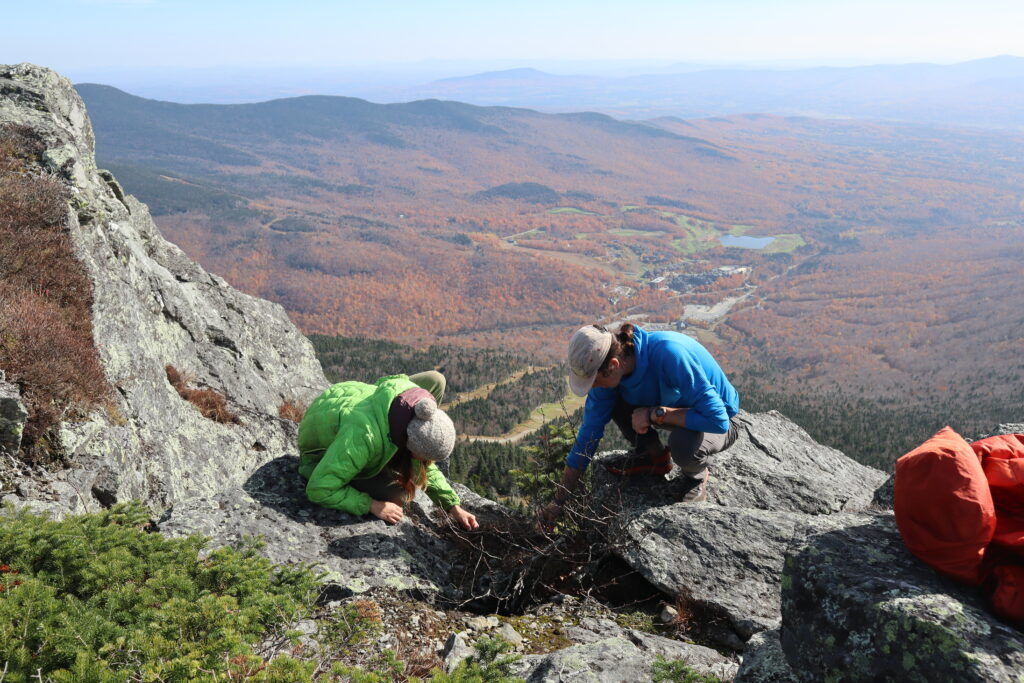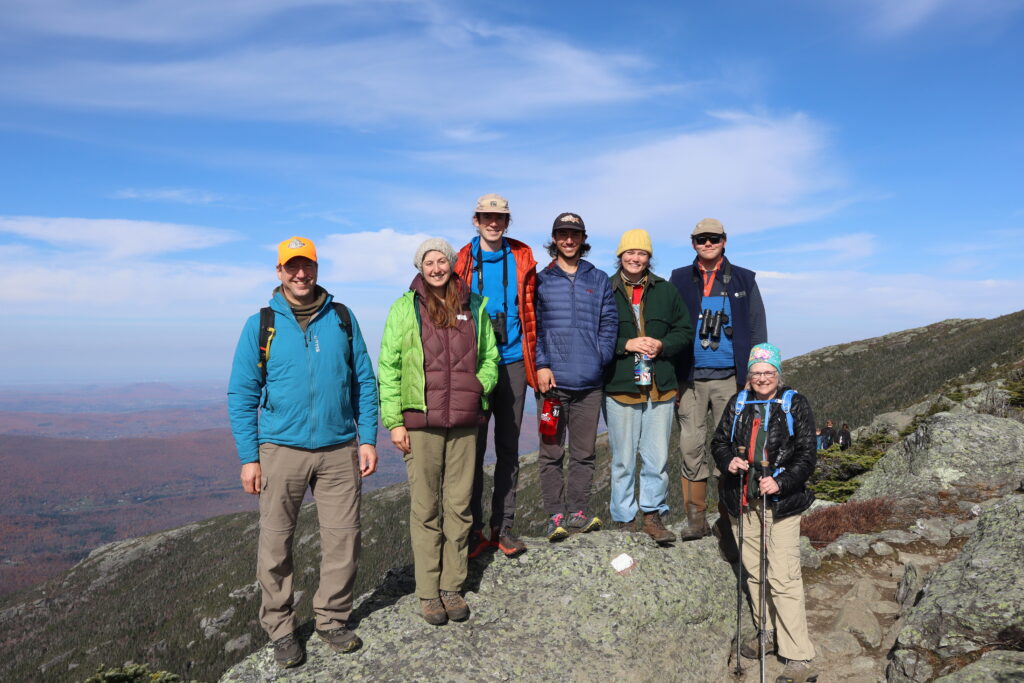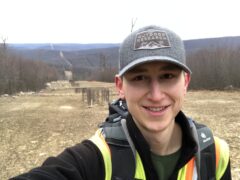Keeping the Life List
Keeping the Life List
By Kevin Berend
Every serious birder keeps a “life list,” a total count of all the species they’ve ever seen. Think of it as peakbagging, but with birds. Some accumulate as many as they can from their backyard, while others get a thrill from traveling hundreds or even thousands of miles in pursuit of the rarest species.
Bicknell’s thrush (Catharus bicknellii), for instance, is a speckled, robin-sized songbird native to high-elevation coniferous forests of the Northeast. It’s also one of the rarest breeding birds in the U.S., consistently near the top of most birders’ lists. It wasn’t until 1990 that genetic analysis showed the species to be distinct from its nearly identical cousin, the gray-cheeked thrush. Even side by side in a field guide the two are difficult to tell apart. All the time I spent above treeline as a summit steward in the High Peaks, I can’t say that I’ve ever seen one.

I’m hoping to change that when I pull into a gravel parking lot outside Stowe, Vermont, last October. I am meeting six others—all, like me, attendees of the Northeastern Alpine Stewardship Gathering—for a field trip on Mt. Mansfield led by Kevin Tolan of the Vermont Center for Ecostudies (VCE). Tolan, wearing hat and sunglasses, muckboots, and a pair of binoculars around his neck, greets us warmly and hands out colorful flyers from the back of his Subaru. Introductions made, we pile in for a ride to the top. Immediately I learn that I won’t be adding the Bicknell’s to my list. The birds are gone, Tolan explains as we bounce along the steep, rutted dirt road. They left a couple weeks ago on their yearly two-thousand-mile migration to their wintering grounds in the high-elevation cloud forests of Haiti and the Dominican Republic. Today we’ll be touring their summer habitat and learning about the work VCE researchers are doing to study and conserve this rare bird.
We arrive at the parking area below the summit, don our packs, and begin to trek. “This is ideal habitat,” Tolan explains, gesturing to the wind-stunted thickets of black spruce and balsam fir along the margin of the trail. Mt. Mansfield is the highest peak in Vermont, with the largest area of alpine habitat in the state. Each spring, Bicknell’s thrush return to these slopes (often to the exact same territory) to nest and raise a new generation. Suitable breeding habitat can be found throughout the Northeast, including the Adirondacks, Green Mountains, White Mountains, and Katahdin.

The forests of the Northeast are a hotspot for biodiversity. The Adirondacks, for example, are home to ninety percent of wildlife species found in the northeastern U.S. Alpine areas in particular offer microhabitats for well-adapted species that occur nowhere else. Habitat loss and climate change are substantially altering high-elevation habitats, however. Worldwide, they are warming more rapidly than other habitats, forcing plants upslope and species such as birds, insects, and mammals that depend on them to adapt to increasingly unpredictable conditions. Some of the more marginal Bicknell’s thrush habitat in the Catskills and Mt. Greylock, for example, is already disappearing, Tolan says. Add to that political and economic instability in Hispaniola that has contributed to rapid deforestation there, further threatening the species. VCE is working with Haitian and Dominican partners, Tolan tells us, in a continental effort to preserve a viable future for the birds.
After half an hour of hiking, we stop at an outcrop with a sweeping westward view. Late-autumn color hugs the city of Burlington and the sparkling silver of Lake Champlain. Beyond, the High Peaks of the Adirondacks rise through a rolling bank of clouds. As we chat, ADK Summit Steward Liam Ebner hops across the rocks.
“I was poking around in the vegetation and seeing a lot of common species,” says Ebner. “Then I saw what I recognized as a crowberry plant. I started looking a little closer and saw that it had fine white hairs along its stem, which identifies it as purple crowberry.”
Ebner pulls up information about the species on his phone and is surprised to find it listed as extirpated in Vermont, last seen in 1908. It was a “light bulb moment,” he later said. Ebner reported the observation to Vermont Fish and Wildlife Department botanist Bob Popp, who called it “an extraordinary find.” The story was picked up by local news outlets, which hailed it as an improbable example of ecological sleuthing and recovery.

Plus one for my life list after all.
Trained Eyes
Crowberries are low, trailing evergreen shrubs with small, needle-like leaves that grow in acidic soil on open ledges and plateaus, usually at high elevation. The name comes from the fact that they are a staple food for birds, such as Bicknell’s thrush, which eat (and deposit) its plump fruits. Black crowberry (Empetrum nigrum) is relatively common across the Northeast. Purple crowberry (Empetrum atropurpureum), on the other hand, is not. In New York, where it is listed as “critically imperiled,” purple crowberry can be found on nine peaks, according to the New York Natural Heritage Program (NYNHP). Nearly all populations are small and threatened by trampling from hiker traffic. I spoke to NYNHP Chief Botanist Rich Ring about the significance of the find in Vermont. “It’s a testament to the summit stewardship program and having more people trained to turn a closely observant eye to what’s around them,” he said.
Summit stewards frequently spend time searching for rare plants above treeline. They review historical records and maps, often striking out with little more to go on than dingy handwritten notes from decades or even a century ago. “You feel like you’re on a scavenger hunt,” says ADK Stewardship Manager Kayla White. White herself used a historical record to discover new populations of mountain firmoss (Huperzia appressa) on Hurricane Mountain in 2021. NYNHP has a 1939 record of purple crowberry on one of the more remote High Peaks, where stewards hope to do the same.
Other discoveries have been the result of chance. For example, stewards had been monitoring a population of squashberry (Viburnum edule), a small shrub that grows along high-elevation streambanks, on the Van Hoevenberg Trail up Mt. Marcy. While hiking in similar habitat through Cold Brook Pass, a steward noticed a few plants, took a GPS point, and filled out a report—a new population on the books. In 2018, White stumbled upon Rand’s goldenrod (Solidago randii), an imperiled cliff-dwelling species, while leading a guided hike on Hurricane. In 2020, steward Cameron Dunn noticed a clump of sedge on Wright Peak that didn’t look like others nearby, identifying it as northern single-spike sedge (Carex scirpoidea). Though in a “very obvious spot,” the plant was previously unknown to that summit. I asked White about this, how official lists can sometimes become blinders. “I think that’s the lesson about the purple crowberry on Mansfield,” she said. “They weren’t looking for it anymore.”
Summit stewards are mostly self-taught botanists. Usually they are college students, not necessarily trained in natural resources. “I came into the summit steward program from a mechanical engineering background,” says Ebner, “so I had no biology background whatsoever. All of the botany education I had was on the job.” Despite their amateur status, summit stewards, as front-line observers, are best placed to make discoveries. Through long hours spent hiking remote trails and inhabiting the summits in all weather, they develop well-trained eyes, a gestalt for the local environment that only comes through careful, close attention. Stewards, says Ring, “might be new to botany but are professionals working to conserve those areas.”

Backcountry Biologists
Summit stewards’ role in regional conservation has grown significantly since the program’s founding. Aside from their main purpose of educating hikers about the importance of staying on the rocks, they also participate in several long-term studies.
The Alpine Population Study (a collaboration with NYNHP) is a wide-scale snapshot of New York’s rare alpine plant communities. Every six years, two stewards bushwhack to and resurvey more than three hundred plots across the High Peaks. Three rounds have been conducted so far. The study is intended to examine changes in abundance and composition over time, particularly in response to climate change.
Photopoint monitoring, conducted every five years, is a long-running project in which stewards meticulously stage and retake historic photographs to track trailside trampling impacts. The photos generally show a remarkable recovery in alpine vegetation since the 1970s. Now digital, they are analyzed by software that precisely quantifies year-to-year changes in vegetation, bare soil, and rock. This new data informs management actions, for example, how trampling is affected by the duration and frequency of summit steward presence or whether trail closures, signage, string fence, or trail maintenance such as brushing and scree walls are having the intended effect.
Mountain Watch is a citizen science initiative run by the Appalachian Mountain Club that monitors the phenology (the timing of seasonal life cycle events) of certain alpine plant species across the Northeast. Every day in spring and at least once per week during the growing season, stewards record the phenological phase (leaf out, flower buds, flowering, senescing, etc.) of a few focal species at plots on Marcy and Algonquin. The data can be compared across peaks and correlated with regional climate trends to assess if warming is causing sped up or advanced phenology. Mismatch, such as flowering before pollinators are active, could pose a serious threat to the long-term viability of certain alpine plant populations.
It doesn’t stop at plants. Stewards have also been involved in collaborations to study American martens, install camera traps for mammals in spruce-fir forest (both with New York State Department of Environmental Conservation), the Empire State Native Pollinator survey (NYNHP), and collecting samples of high-elevation mosses to determine their rates of dispersal (SUNY Oneonta). “People see summit stewards as educators, your friendly greeter who talks to you about the plants,” says White, “but I don’t think they get a full scope of all that we’re doing up here.”
Mountain Birdwatch, for example, is a VCE citizen science program that monitors ten species of montane breeding birds across the Northeast. Surveys are conducted each June on twenty-one routes in the Adirondacks. White told me about her first time doing the survey as a summit steward, in 2016:
“I would hike to Johns Brook Lodge the night before, then wake up at two or three in the morning and start hiking up the Orebed trail in the dark. It was so much fun—the stars, being on that slide. The first point is the Saddleback-Gothics junction, where you have to wait until right before sunrise. Bicknell’s thrush is usually the first bird you hear, and then you start hearing more and more. Especially in that location, near the amphitheater, you hear the birds from Gothics and Saddleback as it becomes a crescendo of birdsong.”
A New Perspective
On the surface, the life of a summit steward might seem routine, even boring. Hike the same trails every day, stand on the same mountaintops, deliver the same message to thousands of people. But there are few opportunities like it for complete immersion, for learning, for transformation through relationship with this wild, ancient land. It is one of the program’s great strengths. Stewards develop a familiarity with the peaks and trails that easily translates into a deep sense of care and duty. When a scree wall is out of place, stewards fix it; when a cairn is toppled, they rebuild it; when a string fence is broken, they repair it; when a social trail develops, they cover it with brush so no one follows. Stewards gain a perspective that few others have and notice things that most people, even professional botanists, might miss.

Bicknell’s thrush and purple crowberry are just two examples. Of course, rare species are more than checkmarks on a list. The future demands that we manage our alpine habitat not as a collection of parts but as a unitary, interdependent system. In that sense, closeness is an asset. Preservation efforts will be increasingly reliant on local individuals and communities who notice when things aren’t right. People who are paying attention.
Ebner credits his experience as a summit steward for a shift in career path. “After my first summer as a steward, I realized I didn’t like engineering as much as I thought I did. I was more passionate about other fields, like outdoor education and conservation.” This year, he is overseeing the program as its new coordinator.

Kevin Berend is an environmental scientist and former ADK summit steward based in Escalante, Utah.
Support Summit Stewards
Related
ADK Rebuilds Vandalized Wright Peak Cairns
On September 15, 2025, nearly every rock cairn above treeline on Wright Peak was destroyed. […]
The Summit Stewardship Program: Leading the Way in Visitor Use Management
In the 1990s, the summit stewards working on Mount Marcy had a problem. The Summit […]
Summit Stewards Reflect on 2023 Season
November 6, 2023 — Lake Placid, NY — In its end of season report, the […]
Extirpated Alpine Plant Discovered on Algonquin
August 29, 2023 — Lake Placid, NY — The Adirondack High Peaks Summit Stewardship Program […]

